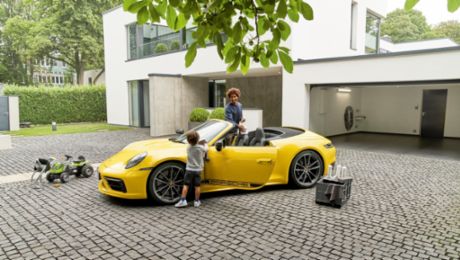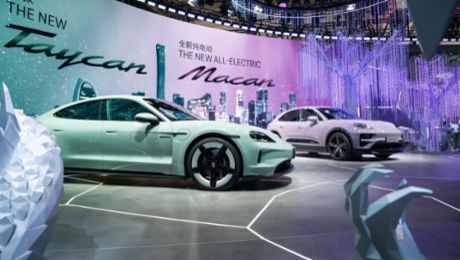The new Macan 4 and the new Macan Turbo have a lithium-ion battery fitted low down within the chassis, of which roughly 95 kWh of the 100 kWh gross energy content can be actively utilised. A lightweight but sturdy glass fibre composite underbody guard protects the high-voltage battery from mechanical damage from below. A cooling plate is integrated into the battery housing. Twelve modules, each with 15 prismatic cells connected in series, are mounted on it. Prismatic cells have their own aluminium shell and are therefore exceptionally stable.
The anode, which accepts electrons and is therefore responsible for charging the battery, chemically consists of 100 per cent graphite. Graphite anodes offer high mechanical stability and good cycle stability. They also exhibit a slight change in volume during the charging and discharging cycle. These properties make them very robust and contribute to the service life of the batteries. The mixing ratio of nickel, cobalt and manganese is 8:1:1. Thanks to this cell chemistry, the battery achieves a high energy density.
During development of the high-voltage battery for the new Porsche Macan, there was also a focus on repairability. The twelve modules and other important components can be replaced individually if necessary, allowing the battery to be efficiently repaired.
The electrical control centre of the vehicle, the battery management system (BMCe), is seated on the battery cover. It distributes the electrical power between the electric motors and the high-voltage auxiliary consumers and enables DC charging with both 800 and 400 volts. Other tasks include monitoring the individual cell voltages and the entire current flow of the high-voltage system. This contributes to a long battery life. Safety components such as a pyrotechnic isolation unit and fuses are also integrated into the BMCe. If an overvoltage or short-circuit should occur, the high-voltage system is automatically switched off and can no longer be started. This also applies if a crash is detected and a restraint system (e.g. an airbag) is triggered.
Space-saving and efficient: the Integrated Power Box
Porsche has developed an innovation for the packaging of the electronic components and has applied for a patent. The Integrated Power Box (IPB) combines three components: the onboard AC charger, which converts alternating current (AC) into direct current (DC) during charging; the high-voltage heater, which controls the temperature of the high-voltage battery and the passenger compartment; and the DC/DC converter, which supplies the 12-volt vehicle electrical system. With a total weight of 19 kilograms, the IPB is about 3 kg lighter than conventional components. It is also very compact and as such it has been possible to position it under the rear bench seat above the battery to save space. This packaging optimises the weight distribution of the vehicle and enables a large front luggage compartment.
The high-voltage heater can be used to heat high-voltage components, such as the battery, in colder months. This keeps the battery in an optimal temperature window. This applies to both driving and charging. Thermal preconditioning is also carried out by the Porsche Charging Planner using the route planning function.
Robust and fast: charging with up to 270 kW
The powerful battery and high charging capacity are the key to efficient, fast travel. The Premium Platform Electric (PPE) comprises an 800-volt architecture that enables the new Macan models to achieve a DC charging power of up to 270 kW. The battery can be charged from 10 to 80 per cent (SoC) within approximately 21 minutes at a suitable fast-charging station.
The new all-electric Macan can charge rapidly over a very wide state-of-charge range (SoC range) – with the battery temperature and weather conditions having relatively little impact on the charging time. Up to about 55 per cent SoC, the Macan is capable of achieving more than 200 kW of charging capacity. This enables it to recharge for a range of up to 250 km in 10 minutes. The battery is preconditioned for an optimal charging experience.
At 400-volt charging stations, the battery is divided by means of a high-voltage switch. Before charging, the 800-volt electric circuit is switched into two separate 400-volt electric circuits. This effectively splits the 800-volt battery into two batteries, each with a 400-volt rating. This enables highly efficient charging with a capacity of up to 135 kW – without an additional HV booster. If necessary, the states of charge of the two battery halves are first aligned before they are charged together. The SoC can be charged from 10 to 80 per cent within about 33 minutes.
AC charging with up to 11 kW is possible at standard household wall boxes. For example, the battery can be charged from zero to 100 per cent overnight at home in around 10 hours. The Porsche Mobile Charger or the Porsche Wallbox are available for convenient charging at home. The Macan comes standard with two charging ports in the rear. The AC/DC connection is on the left on the driver’s side, while the AC connection is on the right, on the passenger side. The charge port doors are manually operated as standard. The optionally available electric charge port doors are illuminated and can be opened via a touch gesture using a sensor in the tailgate or alternatively via the PCM.
A new control unit (Smart Actuator Charger Interface Device, or SACID) controls both charging sockets. The advantage for customers is that Plug & Charge becomes even more convenient. Anyone with a corresponding charging electricity contract will receive a digital certificate. Once this has been installed in the car, the corresponding vehicle function is activated automatically. With the help of the software key, the charging station and car communicate independently as soon as the charging cable is connected. Further authentication via an app, RFID or credit card is not necessary.


